Consider: A patient presents to your office and asks for a contact lens to conceal a birth defect. She has a disfigured, incomplete, non-sighted eye that is smaller than the fellow eye (see figures 1 and 2). The challenge is to fit a lens that will match her healthy eye in color, size and alignment. Would you be able to accommodate this patients needs?
Cosmetic contact lenses have evolved far beyond the original designs, giving you more options to fit a variety of patients. The first cosmetic contact lenses were only suitable for light-eyed patients. Enhancer tints were single-colored lenses produced with a dot-matrix print pattern on the front surface of the lens. The introduction of opaque lenses in 1991 made these lenses available to darker-eyed patients as well. Today, your patients can choose from various shades of colors and even create a monstrous look with decorative lenses.
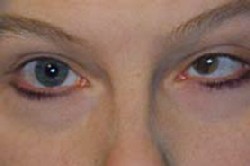
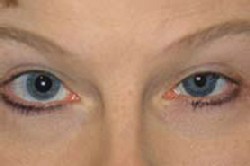
1. A patient with a disfigured, non-sighted eye. 2. The same patient after being fit with a hand-painted, custom designed contact lens to create better cosmesis.
But the efforts that have gone into furthering the cosmetic lens process arent just for fun. Cosmetic contact lenses can allow you to help patients whose eyes are disfigured, to treat diplopia, and even to help thespians achieve frighteningly realistic costumes.
Active Lifestyle A Different Way to Tint
Stephen Johnson, O.D., of San Ramon, Calif., has fit many patients with lenses that help them in sporting activities. We all know the value of contact lenses vs. glasses for sports, he says. If we can improve the visual performance even more by adding a custom sports tint to the lens, patients are even more pleased.
Like sunglasses before them, contact lenses can be tinted different colors for better vision during sporting activities. A green tint, for example, can make a tennis ball appear darker, offering patients a better view of the ball in motion. A yellow tint enhances the appearance of a baseball. Skiers can benefit from a blue- or violet-tinted lens, which will absorb light from the sky and snow to minimize glare. Some manufacturers offer lenses already tinted for sports applications.
Optometrist Stan Harper, president of Adventures in Color Technologies in
Golden, Colo., fit professional skier Picabo Street with specialty contact lenses. She was doing so many interviews on the slopes, and she couldnt look into the camera because of the glare from the sun and the snow, he says.

Troy Glaus, infielder for the Anaheim Angels, wears tinted lenses to help him see the ball more clearly.
Dr. Harper fit her with lenses that had a sunglass color in the center so that her iris color was not changed. Also, because a red/orange or brown lens absorbs light from the UV region, depth perception is maximized, which could be helpful for a variety of sports.
Baseball players Troy Glaus and Mark McGwire are both patients of Dr. Johnsons. Each had trouble seeing the ball, so Dr. Johnson added a yellow sports tint to their contact lenses. This reduced glare and made the image of the ball sharper and crisper. (See A Different Way to Tint.)
Color Vision
Tinted lenses can often enhance a color-deficient patients ability to discriminate more shapes and numbers on the Ishihara test. While tinted spectacles are a viable option for these patients, contact lenses provide full pupil coverage, limited peripheral glare, and greater selective spatial transmission due to a reduced number of optical surfaces.
The X-Chrome red-tinted monocular contact lens was widely used in the 1980s. The PMMA lens transmitted light in the 590 to 700nm wavelength range. Today, more options are available in soft lenses.
Lens Dynamics ChromaGen line of tinted contact lenses recently received FDA approval for daily-wear to enhance discrimination in patients with protan or deutan (red-green) color deficiencies. These lenses aim to modify the spectral energy composition of retinal stimulus, altering brightness, hue and saturation.
ChromaGen is offered in pink, orange, violet, yellow, green, aqua, magenta and blue, depending upon the individuals color vision perception. The manufacturers recommend using a different color filter of the patients preference on the non-dominant eye to create a controlled contrast. In clinical trials, more than 97% of the 275 participants reported a significant improvement in their color discrimination.1
Make sure these patients know that these lenses are not a cure for their conditions. Also, while tinted lenses may help patients distinguish more colors, they should not be used to bypass strict vision requirements for flying or other activities.
The ChromaGen lens can also be used for patients who have unexplained reading problems. A Turkish study published last year investigated the effects of tinted contact lenses on contrast sensitivity in healthy patients. They found that colored lenses were associated with a reduction of contrast sensitivity.2 Tinted lenses may reduce blur or movement for some patients who experience visual discomfort while reading.
Optometrist Stephen Johnson of San Ramon, Calif., has found a new way to tint soft contact lensesin his office. Dr. Johnson uses the FDA-approved In-Office Tinting system from SoftChrome.
The SoftChrome system allows you to tint lenses for any purpose, from sports to therapeutics. You can tint the lens to any density, depending on the patients condition. And, using the systems eight color options, you can create completely individualized colors.
A recipe book included with the system tells your technician which dyes can be combined to achieve the desired color. Optometrist Mitch Cassel says it takes technicians about five minutes to tint a lens with dyes from the SoftChrome book. And, next to no training time is necessary because the recipe book guides users through the process.
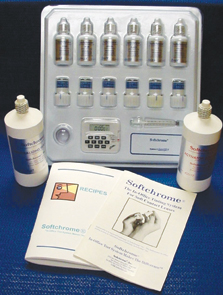
The SoftChrome system can tint any lens with HEMA, including toric, high-plus or minus lenses and bifocals. This means you can often tint lenses that are not available with a tint from the manufacturer. However, once a lens is tinted, Dr. Johnson warns, is it indicated for daily wear only.
Dr. Johnson also says the system is cost-effective for both the doctor and patient. Its probably under $1 a lens to tint a spherical lens in-office vs. $20 at a lab. Torics and bifocals run about $15, which is still economical for the practice, he says.
The SoftChrome In-Office Tinting system contains six tinting cylinders in which the lenses are dyed (two for clear pupils in 10.5mm or 4.5mm diameters, two for solid pupils with a 10.5mm diameter, and two more cylinders for specialty patterns such as starbursts and cats eyes). The system also includes six bottles of different dye colors. Dr. Cassel says each 30ml bottle should tint at least 300 lenses.
He also recommends the Soft-Chromes demonstration palette. The painters-style palette displays seven demonstration eyes that resemble most patients natural eye color. Have the patient choose the false eye that is closest to their own, then place tinted lenses on the palette so patients can immediately see the change. This saves chair time as well because you wont have to spend time doing too many trial fits.
Dr. Cassel says the SoftChrome system has increased patient satisfaction and retention and generated new patient referrals for his practice.
Low Vision
One of the newest uses for cosmetic lenses is to help low vision patients. Optometrist Mitch Cassel of Studio Optix in New York, says that many custom color tints can be aligned with the central pupil to remove glare so that low vision patients can perceive images better. Tinted lenses can be used with or without additional low vision aids, depending on the severity and subjective symptoms of the patient.
This concept has already been shown effective in spectacle lenses. Researchers at Aston University in Birmingham, England, compared the effect of colored spectacle lenses on the visual performance of 10 subjects with age-related macular degeneration vs. five elderly control subjects.3 Patients were assigned wraparound spectacle lenses in various tints: yellow with a 29.7% light transmission, orange with 22.9% transmission, red with 16.8% and gray with 10.3%.
While the increase in contrast sensitivity was minor, patients reported subjective benefits while wearing the lenses. Specifically, red and gray lenses reduced contrast sensitivity whereas yellow and orange lenses increased sensitivity. Visual acuity and peripheral sensitivity decreased when normal patients wore red lenses, and color vision became blurred.
Some studies have also shown that tinted contact lenses can help alleviate glare and photophobia issues for patients with cataract or age-related macular degeneration. In a 2003 study at New York Universitys School of Medicine, researchers examined the effect of tinted lenses on 25 patients with cataracts.
Patients were fit with a gray, brown, yellow, green or purple-tinted lens. All subjects demonstrated an increase in contrast threshold under glare. But, the researchers concluded that a yellow or brown lens may help alleviate glare for patients with lenticular changes.4
Dr. Harper currently offers several tints for patients with low-vision conditions. Generally, contact lenses with color are more effective than the same color in eyeglasses, since there is no white light interference when the lens color rests immediately adjacent to the cornea, he says.
One suggestion: Align the tint within the central pupil for these patients. Make sure the pupil diameter of the lens is greater than that of the patients pupil. This will help when going between varying light conditions. The lens must be stable, with minimal movement, so as not to expose the underlying pupil to too much light.
Special Effects
Ever wonder what makes those movie monsters look so real? Besides masks and makeup, many actors use specially made contact lenses to complete their costumes. Both CIBA Visions WildEyes and CooperVisions Crazy Lenses have been used for this purpose.
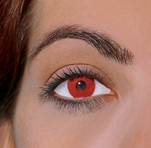
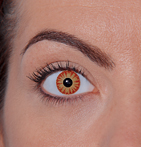
Cosmetic lenses, like the starburst and vampire looks above, are often used for theatrical purposes.
Dr. Cassel has been working with theatrical lenses for 20 years. He was working in Manhattan when a college student approached him about obtaining a certain unusual colored lens available in Europe. He was in a college production and wanted to turn his eyes a different color. I became determined to help him. One thing led to another, and I was eventually able to obtain some different options from contact lens manufacturers.
Since then, he has worked on more than 750 productions to help actors create a range of looks from natural eye color changes to scarred, diseased, bloodshot eyes, to a supernatural mirrored effect.
Dr. Cassel is also president of Custom Color Contacts in New York. He initially started the company to create contact lenses for theatrical purposes. Meeting the actors is fun, but the most rewarding part of my career has been in prosthetic lenses, he says. When I saw these lenses larger than life on the big screen, I recognized they could also be applicable to patients with scarring, either congenital or from traumatic injuries, he says.
Therapeutic Uses Realigning Self-Esteem Cosmetic Lenses for a Non-Sighted Patient
A variety of ocular disorders can be corrected by colored contact lenses. (Of course, you should rule out possible pathology before prescribing lenses for any of these conditions.) Among them:
Diplopia. A dark, black, opaque tinted lens that completely eliminates light can help eliminate double vision for some patients. When the full central lens area is opaque, contact lenses can eliminate images and provide acceptable cosmesis for patients with intract-able diplopia.
By Mitch Cassel, O.D.
A 36-year-old performer born with a disfigured smaller, incomplete, mis-directed, non-sighted eye. He came to our office because he was conscious of the difference in size between the two eyes while performing. This patient needed a lens that would match his healthy eye in color, size and alignment.
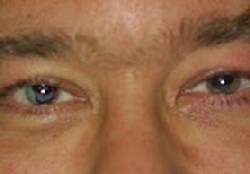
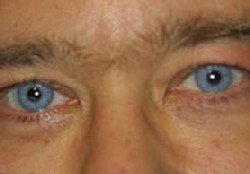
We fit this patient with a new, hand-painted laminated large scleral lens design that conceals his natural eye in order to realign the new hand-painted iris. Digitial photography greatly assisted our artists in matching the patients other eye.
The patient has now regained his self-esteem and feels more confident on stage. He wears the lens every day with a smile.
Studies have shown that as long as patients do not have unreasonable expectations and the lens is well cared for, tinted contact lenses can be useful as an alternative to a covered spectacle lens or eye patch when occluding one eye.5
Aphakia and amblyopia. Many O.D.s have also found success in treating childhood aphakia and amblyopia with black, occluded contact lenses versus patching. Contact lenses offer compliance benefits over patching due to better cosmesis. Its more difficult for a child to remove a contact lens than a patch and, because their appearance is less affected, children are less likely to be self-conscious.
Canadian researchers evaluated the responses of 123 caregivers of children with cataracts who were prescribed either patching or an occluding contact lens. Although initial resistance to therapy was high with contact lenses, this decreased with time and contact lenses were well-tolerated by most patients.6 Researchers also noted this was an easy treatment option that resulted in longer wearing time with low rates of complication and dropouts.
By Mitch Cassel, O.D.
A 21-year-old woman came to our office from Greece. She was completely blind with no light perception secondary to a mismanaged glaucoma complication. This left her with perforated corneas and eventual leukokoria.
The patients mother had found our office and brought her daughter in because everyday someone would ask what was wrong with the girls eyes. She wanted a custom-designed lens that was natural looking and would give her a more normal experience.
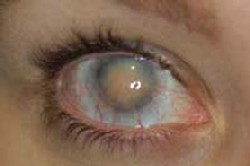
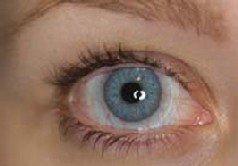
We designed a hand-painted, custom lens with natural looking irides to cover the patients disfigurement. Although this patient never saw the lenses, she became very emotional just knowing she had natural looking eyes. Now, she doesnt go anywhere without her new lenses.
When people come in with these disfigurements, there is no smile, no self-esteem. We make it our mission to get a smile out of those patients as the end result. We know we are successful when we get that smile at the end.
Clinical pearls:
Working with patients who have a disfigured eye can be a very moving experience. So, be prepared for the patient to be emotional.
Also, be sure not to give these patients unrealistic expectations. No matter how closely you can match the patients healthy eye, a contact lens will never be a perfect match.
A study from Sweden found that contact lenses were successful in treating persistent amblyopia in high unilateral myopia.7 And, a retrospective case review of patients with anisometropic amblyopia treated at the Strabismus Service of Moorfields Eye Hospital in London found that contact lenses improved visual acuity in myopic aniso-metropia of up to 9.00D.8
Albinism. Occluding lenses also may help control the amount of light that enters the eyes of patients with ocular albinism. Dr. Cassel says the lack of iris pigmentation causes extreme photophobia and macular complications if the eye is exposed to too much light. He recommends fitting a darker brown or gray solid iris color lens to act like a sunglass. The diameter of the colored iris should be 2 to 3mm larger than the patients pupil in dim illumination.
Prosthetic Uses Lens of A Different Color
Patients who present with a disfigured eye, whether congenital or from trauma, are the most challenging and, the doctors say, the most rewarding. Weve seen everything from older patients with surgical complications to teenagers in accident cases, and weve changed a lot of lives, Dr. Harper adds.
Dr. Cassel agrees. With prosthetic lenses, its often an emotional experience for myself, my staff and the patient. We often develop a bond with the patient that lasts for years, he says.
But be very careful not to foster unrealistic expectations in these patients. Make it clear that you will never be able to get their real eye back. A realistic prosthetic lens may come close to matching their eye, but it will never be exactly the same, Dr. Cassel says.
Custom Color Contacts uses digital photography of the patients non-disfigured eye to produce a hand-painted contact lens that is as close to the original eye appearance as possible. The artists can control every design aspect of the lens, including pupil size, base curve, iris color and base color, and can even add iris flecks.
Prosthetic lenses may be of particular help to patients who have:
By Mitch Cassel, O.D.
A 45-year-old patient presented to our office with a yellow opaque right eye that was totally blind and disfigured. His condition developed secondary to infection that resulted from cataract surgery complications. He wanted a custom-designed, laminated soft lens so that his right eye would match the healthy, normal, blue left eye.
Light eye matching is always challenging because the eye is translucent and reflects various colors depending on lighting conditions, clothing, etc. We used high-resolution digital photography so that the artists who work on the lenses could match the details of the prosthetic lens to healthy eye.
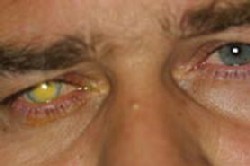
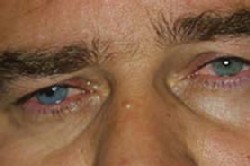
The patient was very happy with the lens we designed and fit. In fact, he told us his brother asked whether he had a transplant because the lens looked so natural.
Clinical Pearls:
Enhancer tints are generally suitable for light-eyed patients who want to change their eye color, but not for patients who need to cover disfigurement. They will allow some, or all, of the eye underneath to show through.
Light-eyed patients in this category are particularly challenging to fit. Opaque lenses may be too dark to match the fellow eye. Consider using a custom-designed lens in these cases.
Digital photography of the patients healthy eye can give labs and manufacturers a very detailed picture from which to work.
Aniridia. Patients with aniridia, whether due to a congenital defect, trauma or iridectomy, can suffer from extreme photophobia as well as disfigurement.
A custom, hand-painted laminated soft contact lens can provide very precise color and detail. The lens can also be modified to recreate a normal iris opening to reduce glare and provide normal light perception.
Fixed pupils. Permanently dilated pupils secondary to trauma or disease can cause significant glare. Prosthetic lenses can now be made with a clear central pupil opening and opaque iris coloring to mimic the natural iris. Good centration and stability are necessary for these patients.
Dr. Cassel says many patients will also benefit from a black underbacking to eliminate glare. Most manufacturers can accommodate this request in their opaque contact lens lines.
Strabismus. Prosthetic lenses can help realign a non-sighted strabismic eye without surgery. Large scleral lenses are truncated to stabilize the lens, and can be painted with iris imprints off-center to precisely match the alignment of the fellow eye. An opaque, white edge conceals the underlying off-centered iris. Dr. Cassel says that trial fits and accurate photos are the best options to carefully measure the degree of misalignment.
Heterochromia. Patients with heterochromia can benefit from either enhancer or opaque colors, depending on the patients preference and individual characteristics. Dr. Cassel says it is often very easy to offer two brown enhancer-tinted lenses that will overlap the patients natural eye color. Opaque lenses can work well if the patient desires lighter eyes.
Leukokoria. Prosthetic lenses can be used to conceal leukokoric opacities caused by disease or trauma. Hand-painted opaque lenses are often used to match the normal iris color detail and pupil size. CIBA Visions Special Eyes Foundation will also manufacture lenses for these patients if provided with a photograph of the normal eye and corneal measurements.
Always recommend patients with trauma wear eyeglasses as well as their contact lenses. This will help to camouflage the prosthetic lens, and to protect their good eye from possible injury, Dr. Cassel says.
Cosmetic lenses arent just a novelty for Halloween. You have many options from which to choose to help your patients change the way they see the world and, in some cases, the way the world sees them.
1. Harris DA. Coloring sight: A study of CL fittings with color enhancing lenses. Optician 5604:213;38-41.
2. Ozkagnici A, Zengin N, Kamis O, Gunduz K. Do daily wear opaquely tinted hydrogel soft contact lenses affect contrast sensitivity function at one meter? Eye Contact Lens 2003 Jan;29(1):48-9.
3. Wolffsohn JS, Dinardo C, Vingrys AJ. Benefit of coloured lenses for age-related macular degeneration. Ophthalmic Physiol Opt. 2002 Jul;22(4):300-11.
4. Naidu S, Lee JE, Holopigian K, et al. The effect of variably tinted spectacle lenses on visual performance in cataract subjects. Eye Contact Lens 2003 Jan;29(1):17-20.
5. Astin CL. The use of occluding tinted contact lenses. CLAO J 1998 Apr;24(2):125-7.
6. Ma JJ, Morad Y, Mau E, et al. Contact lenses for the treatment of pediatric cataracts. Ophthalmology 2003 Feb;110(2):299-305.
7. Gianoli F, Klainguti G. Use of contact lenses for correction of amblyopia in high unilateral myopia in children. J. Fre Ophthalmol 2003 May;26(5):485-8.
8. Roberts CJ, Adams GG. Contact lenses in the management of high anisometropic amblyopia. Eye 2002 Sept;16(5):577-9.

